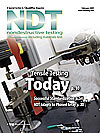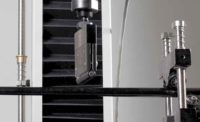
Tensile testing is growing up. This century-old testing method is still used for testing tensile properties of a material under tension, from plastics to metals to rubbers. However, the capabilities of tensile testing systems have matured, allowing companies to get the data out faster and, in the process, save time and money. And of course, access to information has also changed. In the past, for example, tensile testing of ASTM A36 material was not available on YouTube.

Companies are now moving toward noncontact ways of measuring strain. Source: Instron
Basics
Manufacturers are interested in anything that has to do with quantifying the mechanical properties of components, and there are many different ways of qualifying mechanical performance.Tensile testing works well in determining the strength of a material. “Tensile test will tell you a fair amount, but it depends on what you are qualifying the material for,” says Lorenzo Majno, vice president of electromechanical products at Instron (Norwood, MA). “Tensile testing is a nice universal broad-brush place to start,” Majno says, “though a specialized test may be needed for some materials.”
For example, some materials are strain rate sensitive, meaning the faster you pull, the less likely they are to stretch. “Silly putty is my favorite example,” Majno says. “If you pull slowly, it will stretch forever. But if you pull fast, it snaps.”
Another aspect to look at is the ductile to brittle transition, which can happen as a result of speed or, in some cases, as a result of temperature. If a material is warm and then cools off, this is the point where it starts breaking like glass. For example, if car parts are used in Alaska, and the driver backs into something, they do not want the bumper to shatter like glass, Majno says. To accommodate these varying elements, many tensile testing machines have environmental testing chambers.
While there may be different methodologies, these tests could be done with the same accessories and instrument. This provides leverage for the industry. “The more we manufacturers can address multiple industries with the same product, the more economy of scale, more competitive price,” says Dan Plazek, field account manager at MTS (Eden Prairie, MN), a company focused on modular systems. The beauty of a modular system, for both the manufacturer and the customer, is that equipment does not need to be constantly updated and the same basic machine can work for widely differing industries, Plazek says.
The MTS Insight electromechanical testing system performs simple and complex monotonic material tests, including tension and compression; MTS also offers an extensive range of accessories, from extensometers, grips, furnaces, chambers or anything else needed to augment a tensile test, Plazek says.
Because the steel industry is looking for something different than the rubber industry than the plastics industry for their test and inspection requirements, Plazek points out that different features can be added to the individual machines.
“We’re seeing a steady growth in just about every business sector we’re involved with, Plazek says. “Not just North America, but also Europe and the Pacific Rim. No one market is outshining the other.”

An extensive range of accessories, from extensometers, grips, furnaces and chambers are available to augment a tensile test. Source: MTS Systems
Software
While many facets are growing, the unifying theme has been interest in the data.“What we’re actually seeing is a need for getting the data where it needs to be as soon as possible,” Plazek says.
In the past, according to Plazek, the value of tensile testing from the customer perspective was finding the most accommodating grips, but it has changed to, “How quickly can I get data to my customer?”
The goal is to get the operator out of the equation, and have the system generate raw data or a report automatically at the end of a sample as part of the methodology. “This cuts out an awful lot of time, which is money, and cuts waste, which is also money,” Plazek says.
It helps the operator better use his time and do the test properly.
“The less human hands touch that test, the more repeatable that test is going to be,” says Bill Fahrbach, vice president of sales at Mecmesin (Sterling, VA).
As streamlined data grows in importance, customers make their requests known.
“The back end of the software is becoming something we are discussing a lot more,” Plazek says. The goal is to make reports simpler and get results into databases and servers.
A lot of customers are looking to deploy a standard solution, with one supplier and one type of equipment, Plazek says. While companies want to have a standard solution, they are also looking for commonality to avoid a complete rewrite of their systems.
“The industry seems to be growing quite a bit in sophistication for virtual tools,” Plazek says.
MTS introduced Windows software in the early 1990s. Just as the PC industry migrated and infiltrated all aspects of our lives, Plazek says, it has been the same in the tensile testing industry.
“It has been an evolutionary progress, not a revolutionary one,” Plazek says.
The MTS TestWorks software is deployable across a range of testing disciplines, from tensile testing to fatigue to fracture mechanics, and also can be used on a variety of testing machines. Having software that is able to deploy on any make, model or vintage of tensile testing machine allows companies to keep the older equipment running current and saving capital dollars.
The profile of those using tensile testing varies, according to Plazek. Some customers have one lab and one machine, and are simply looking for basic data to qualify their products. The value proposition for them is the cost of entry of doing that type of testing. These “reluctant participants in tensile testing” just want a low-cost solution that does the basic test, Plazek says.
However, other customers want to comply with industry requirements and are looking for easier audits.
Others want the capability to change with the industry and are looking to get as much as possible out of their machines and software, as they do cyclic, flexure testing and environmental testing.
For those customers who want to do more complex calculations two years down the line, this allows them to upgrade or accessorize their hardware or software without junking a good machine.
Admet runs a healthy business doing retrofits on machines, says Richard Gedney, Admet (Norwood, MA) founder and president. With many large frames, such as the 60,000-pound, 120,000-pound capacity frames, electronics become obsolete or outdated, but the machine itself is sound. Retrofits allow customers to update the machine without shelling out for an entirely new system.

Universal testing machines can be used for tension, compression, dynamic fatigue and torsion testing. Source: Admet
Features
In a typical tensile test application, operators clamp an extensometer onto a specimen. But now, companies are moving more and more toward noncontact ways of measuring strain, Majno says. They are moving toward video-putting dots on specimen. This can measure stretch in one direction, and also another direction.This involves a high-precision video camera with all kinds of video and lighting. Instron’s advanced video extensometer, or AVE, measures strain on a specimen. The video capabilities allow operators to measure strain on something in a temperature chamber. This is not entirely new-it has been evolving over a past several years, as a step up from the standard video extensometer, or SVE.
A recent development is the robotic specimen handling with a Mitsubishi robot, providing higher quality and higher precision.
Majno, who had recently returned from a trip to Korea, said companies there had an interesting way of looking at the tests. “They want employees working on value-added tasks,” Majno says, “and putting specimen in machine, putting a clamp, was not a value added task. Instead, robots can be used for the job. They can pick up a specimen, wave it under bar code reader, measure it and put it in damping station.”
While robotic specimen handling alone is not new, Instron recently reconfigured its platform for the Mitsubishi robot, along with the TestMaster2 software.
Other areas in development are the software, the goal being to “make it ever faster, easier and more productive to test machines through software,” Majno says. Since so much of testing involves software, and transfer data to and from networks, companies want data management to be as easy as possible.
Majno, who has been at Instron for more than 20 years, says tensile testing has been heading toward testing finished products instead of raw materials.
Instead of the measuring the modulus of materials, companies are now testing syringes, needles, packaging, welded joints, adhesives and products, he says.
So many possible applications means different challenges every time, Majno says, with different gripping needs or features to look for.
Web cameras can help companies hone in on features of interest. If the companies want to see the change in curve, the camera provides visual proof. The camera, connected to an Instron machine, synchronizes video of what is happening in the test. Video allows operators to click on that part of the curve to show what happened in that part of the test.
Future
While tensile testing itself appears to be growing, the testing method is experiencing a particular growth in the medical industry. All the new medical devices coming onto the market need to be subjected to testing, Gedney says, and the types of test that they want to perform for these devices often involve customization. Many traditional materials like plastics, silicone and metals, are engineered into implantable medical devices, and new specifications specifically target how materials are used for medical devices.“More manufacturers and distributors are taking on testing,” says Gedney. “They hadn’t done it in the past, and they are relying on us more and more for advice on how to run the test and what kinds of equipment they need.”
Though the basics of tensile testing-a specimen loaded to failure in tension between self-aligning grips of a tensile testing machine-have not changed dramatically over the years, the specimen being measured is evolving.
This evolution in tensile testing has allowed Majno to continue in this field as long as he has. It can be used from applications ranging from car parts to how hair responds to shampoo to measuring the crunchiness of potato chips, he says.
“Every day there’s something new,” Majno says. ndt
For more information on the companies mentioned in this article, visit:
Admet, www.admet.com
Instron, www.instron.com
Mecmesin, www.mecmesin.com
MTS Systems, www.mts.com



